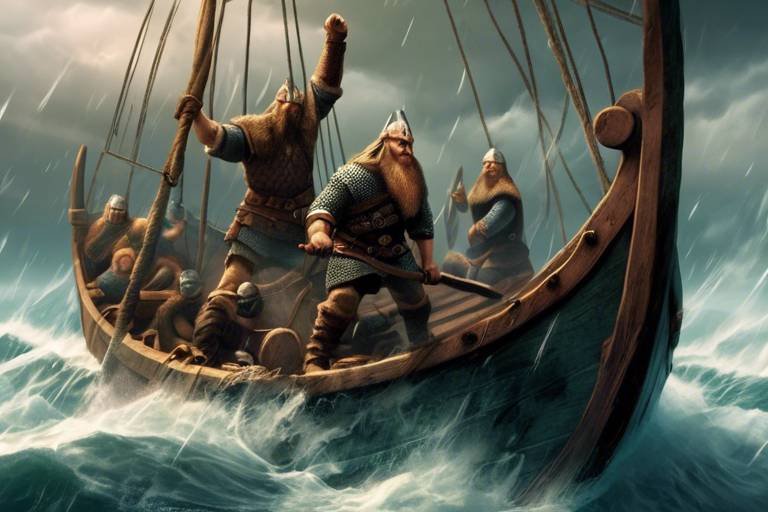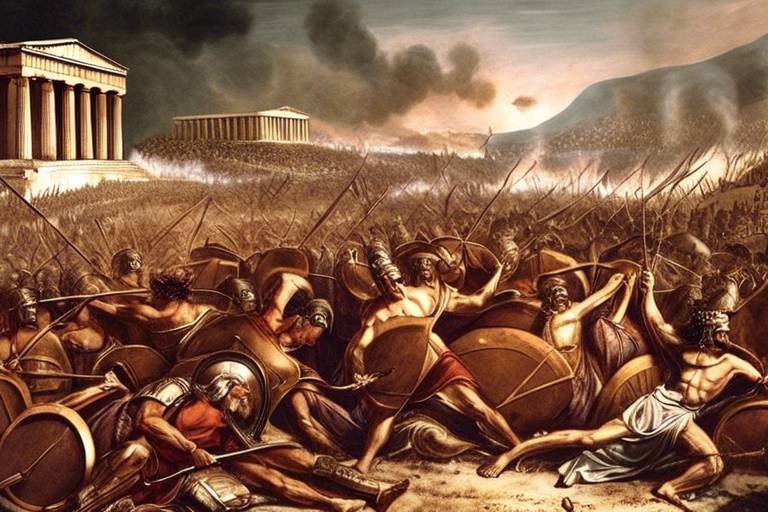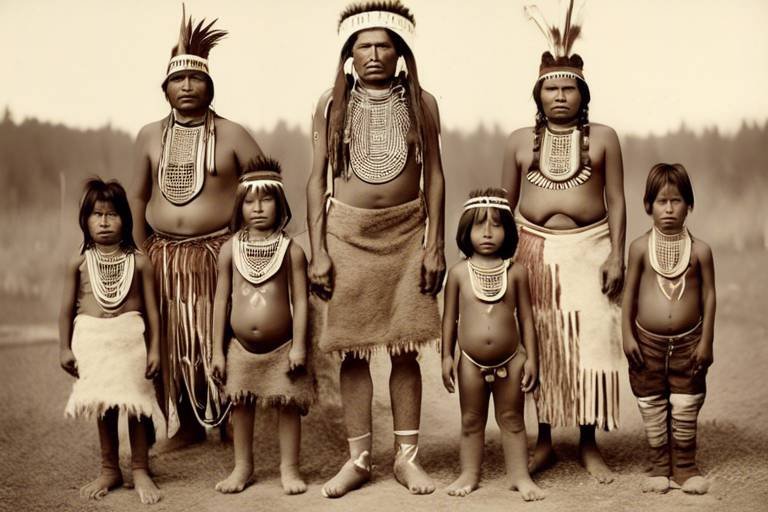Viking Explorations - The Sea Raiders
Vikings, known as the fierce sea raiders of the medieval ages, were not merely marauders but skilled navigators who embarked on daring explorations across vast oceans. Their legacy as fearless adventurers still echoes through history, shaping the world as we know it today. Let's delve into the thrilling tales of Viking explorations and the impact they had on the lands they discovered.

Origins of the Vikings
Vikings were skilled navigators and fierce warriors who explored vast territories by sea. This article delves into the adventurous spirit of the Viking explorers and their impact on the regions they discovered.
The Viking Age began with the raids of Scandinavian seafarers in the late 8th century. These Norse warriors, known for their seafaring skills and combat prowess, originated from the Scandinavian regions of present-day Norway, Sweden, and Denmark. Motivated by a combination of factors such as overpopulation, political instability, and the desire for wealth and glory, the Vikings set sail on daring expeditions to explore new lands and expand their influence.

Viking Longships
Viking Longships were the epitome of maritime ingenuity during the Viking Age. These sleek and sturdy vessels were essential to the Norsemen's exploration and conquests across the seas. Crafted with precision and expertise, Viking longships were designed to withstand the treacherous waters they navigated, allowing the Vikings to travel vast distances with remarkable speed and agility.
The design of Viking longships was revolutionary for their time, featuring a shallow draft and a symmetrical hull that enabled them to sail in both deep oceans and shallow rivers. Equipped with oars for rowing and a single mast with a square sail for propulsion, these ships were versatile and well-suited for long journeys. The prow of the longships often boasted intricate carvings, symbolizing the power and prowess of the Viking warriors who sailed them.
One of the key advantages of Viking longships was their ability to navigate narrow waterways and conduct surprise attacks on unsuspecting coastal settlements. Their speed and maneuverability made them formidable weapons of war, allowing the Vikings to strike quickly and retreat before facing significant resistance. These swift vessels were instrumental in the success of Viking raids and explorations, earning them a fearsome reputation among their adversaries.
Furthermore, the longships served not only as instruments of war but also as symbols of Viking craftsmanship and seafaring prowess. The intricate construction of these ships reflected the Norsemen's deep connection to the sea and their reliance on maritime exploration for trade, colonization, and conquest. The sight of a fleet of Viking longships approaching the shore struck fear into the hearts of those who witnessed it, signaling the arrival of fierce warriors ready to conquer new lands.

Exploration Routes
Viking explorers were known for their bold and daring expeditions across vast expanses of water, leaving a trail of discovery and adventure in their wake. These intrepid seafarers set sail from their Scandinavian homelands, embarking on journeys that would take them to distant lands and uncharted territories.
One of the most renowned exploration routes undertaken by the Vikings was their journey across the Atlantic Ocean. Venturing westward, these Norse adventurers reached the shores of North America, long before the arrival of Christopher Columbus. Their ability to navigate the treacherous waters of the Atlantic and establish temporary settlements showcases their remarkable seafaring skills.
Aside from their transatlantic voyages, the Vikings also explored the Mediterranean Sea, delving into the heart of ancient civilizations and engaging in trade and conquest. Their presence in the Mediterranean left a mark on the region's history, influencing the cultures they encountered.
Furthermore, the rivers of Eastern Europe served as vital highways for Viking exploration. These waterways provided access to the rich lands of the East, allowing the Norsemen to establish trade routes and forge alliances with local tribes. The network of rivers and water bodies in Eastern Europe offered the Vikings a gateway to new opportunities and resources.
As they navigated these diverse exploration routes, the Vikings encountered a myriad of challenges, from harsh weather conditions to hostile encounters with indigenous peoples. Despite these obstacles, the Norse explorers persevered, driven by their thirst for discovery and conquest.
The exploration routes taken by the Vikings not only expanded their geographical knowledge but also facilitated cultural exchanges and interactions with different civilizations. Through their voyages, the Vikings left a lasting legacy on the regions they visited, shaping the course of history and leaving behind a trail of exploration and adventure.

Discoveries and Settlements
The Viking explorers were not only known for their fierce reputation in battle but also for their remarkable discoveries and establishment of settlements in distant lands. Setting sail from their homelands in Scandinavia, these intrepid seafarers ventured into uncharted waters, seeking new territories to conquer and colonize.
One of the most significant discoveries attributed to the Vikings is the establishment of settlements in Iceland. In the 9th century, Norse settlers arrived on the island, braving the harsh conditions to create thriving communities. The archaeological evidence uncovered in Iceland provides insights into the daily lives of these early Viking settlers, showcasing their resilience and adaptability.
Greenland was another key location where the Vikings left their mark. Led by explorer Erik the Red, Norse settlers arrived in Greenland in the late 10th century, establishing farms and trading posts along the coast. The remnants of these settlements, including ruins of buildings and artifacts, offer glimpses into the lives of the Viking inhabitants.
Perhaps one of the most debated discoveries attributed to the Vikings is Vinland, believed to be present-day Newfoundland in Canada. According to Norse sagas, explorer Leif Erikson led an expedition to Vinland around the year 1000, making it one of the earliest known European voyages to North America. While the exact location of Vinland remains a topic of scholarly debate, the Viking presence in the region is supported by archaeological findings.
The Viking settlements in these distant lands not only served as outposts for trade and expansion but also as testaments to the seafaring prowess and adventurous spirit of the Norse explorers. Through their discoveries and settlements, the Vikings left a lasting legacy that continues to intrigue historians and archaeologists to this day.

Encounters with Indigenous Peoples
When the Viking explorers set sail on their daring expeditions, they encountered a diverse array of indigenous peoples in the lands they reached. These encounters were marked by a mix of cultural exchanges and conflicts, shaping the interactions between the Norsemen and the inhabitants of the regions they visited. The Vikings encountered the Sami people in the northern territories, the Inuit in Greenland, and the Skraelings in Vinland. These interactions played a significant role in shaping the perceptions and understandings of both the Vikings and the indigenous peoples they met.

Legacy of Viking Explorations
The legacy of Viking explorations reverberates through history, leaving an indelible mark on the lands they discovered and the cultures they encountered. The fearless spirit of the Norse seafarers not only expanded their territories but also shaped the course of world history.
One of the most enduring legacies of the Viking explorations is the establishment of settlements in distant lands such as Iceland, Greenland, and Vinland. These settlements, though often small in size, demonstrated the Vikings' ability to adapt to new environments and thrive in challenging conditions.
Moreover, the cultural exchanges that took place between the Vikings and the indigenous peoples they encountered left a lasting impact on both sides. Through trade, interactions, and sometimes conflicts, the Norsemen influenced the traditions, languages, and beliefs of the regions they explored.
Archaeological evidence of Viking presence, such as artifacts, structures, and burial sites, serves as a tangible reminder of their expeditions. These discoveries not only shed light on the material culture of the Vikings but also provide insights into their daily lives and interactions with local populations.
Furthermore, the legacy of the Viking explorers extends beyond their physical settlements and artifacts. Their sagas, epic tales of adventure and heroism, have inspired generations of storytellers, writers, and artists, shaping the literary and artistic traditions of the regions they once roamed.
In modern times, the spirit of the Viking sea raiders continues to captivate imaginations, fueling popular culture representations in movies, television shows, and literature. The image of the fierce Norse warriors sailing across treacherous seas in their iconic longships endures as a symbol of exploration, daring, and resilience.
The legacy of Viking explorations serves as a testament to the human drive for discovery, the thirst for adventure, and the enduring impact of cross-cultural interactions. As we look back on the exploits of these intrepid seafarers, we are reminded of the boundless possibilities that await those willing to brave the unknown.

Myths and Realities
When it comes to Viking explorations, a plethora of myths and realities intertwine to create a tapestry of historical intrigue. One common myth portrays Vikings as bloodthirsty savages solely focused on plunder and destruction. However, the reality is far more nuanced. While the Vikings were indeed fierce warriors, they were also skilled traders, craftsmen, and settlers. Their expeditions were driven by a mix of factors, including a quest for wealth, land, and adventure.
Another prevalent myth revolves around the horned helmets often associated with Vikings. Contrary to popular belief, historical evidence suggests that Vikings did not actually wear horned helmets in battle. These embellished helmets were more likely a product of later artistic interpretations rather than authentic Viking attire.
One of the enduring misconceptions about Viking explorations is the notion that they were aimless marauders wreaking havoc wherever they went. In reality, the Vikings were strategic navigators who meticulously planned their journeys, utilizing their advanced shipbuilding techniques and navigational skills to reach distant shores.
Furthermore, the portrayal of Viking interactions with indigenous peoples as solely violent clashes is a oversimplification of the complex reality. While conflicts did occur, there were also instances of trade, cultural exchange, and even intermarriage between the Vikings and the local populations they encountered.
To separate fact from fiction, it is essential to delve into the historical records and archaeological findings that shed light on the true nature of Viking explorations. By examining the tangible evidence left behind by the Norse seafarers, we can gain a more accurate understanding of their achievements, challenges, and contributions to world history.

Modern-Day Impact
The modern-day impact of Viking explorations is profound and far-reaching, extending beyond the pages of history into contemporary society. The legacy of the fearless sea raiders continues to shape various aspects of modern life, from literature to art and even popular culture. The adventurous spirit and daring expeditions of the Vikings have inspired countless works of fiction, movies, and television shows, capturing the imagination of audiences worldwide.
Moreover, the influence of Viking explorations can be seen in the realm of language and place names. Many locations in the regions once visited by the Norsemen bear traces of their presence, reflecting the enduring impact of their expeditions. Additionally, archaeological discoveries continue to shed light on the material culture and technological advancements of the Vikings, providing valuable insights into their way of life.
Furthermore, the spirit of exploration and discovery embodied by the Viking sea raiders serves as a symbol of resilience and determination in the face of challenges. Their legacy reminds us of the importance of courage and ambition in pursuing our goals, inspiring individuals to push beyond their limits and explore new horizons.
Frequently Asked Questions
- What were Viking longships?
Viking longships were advanced seafaring vessels used by the Norsemen during the Viking Age. These ships were designed for speed, agility, and the ability to navigate both open seas and shallow rivers. They played a crucial role in the success of Viking explorations and raids.
- Where did the Vikings explore?
The Vikings explored vast territories across Europe, the North Atlantic, and even reached North America. They traveled to regions such as Iceland, Greenland, the British Isles, and parts of modern-day Russia. Their exploration routes also extended to the Mediterranean Sea and North Africa.
- What impact did Viking explorations have on world history?
The Viking explorations had a significant impact on world history, influencing trade, culture, and political developments in the regions they visited. They established settlements, engaged in trade networks, and left a lasting legacy on the indigenous peoples they encountered.



















